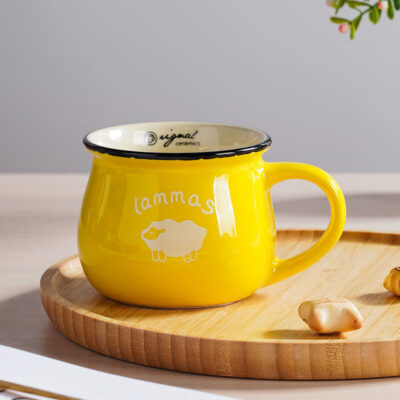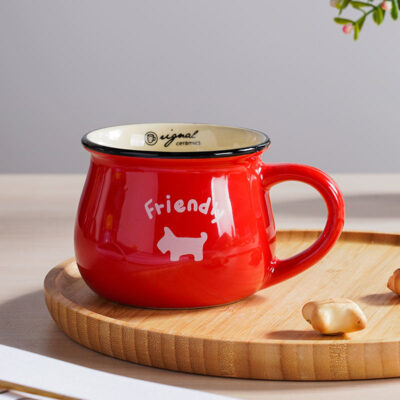A ceramic mug may seem simple, but when it carries your logo, it becomes an extension of your brand. The logo printing process defines how your design looks, feels, and lasts. Whether you’re developing promotional giveaways, café merchandise, or corporate gifts, selecting the right technique is key. This guide explains how each printing method works — and how to choose the best one for your custom mugs.
🎨 1. Decal Printing – The Industry Standard
Decal printing, sometimes called transfer printing, remains the most common method for custom logo ceramic mugs. The process involves printing your logo or artwork onto a special paper, which is then applied to the mug’s surface by hand or machine. After application, the mug is fired in a kiln at low temperature (around 700–800°C) to permanently fuse the image with the glaze.
Advantages:
-
Supports full-color, high-resolution artwork.
-
Ideal for small to medium production runs.
-
Long-lasting and dishwasher-safe.
Best For: Retail brands, cafés, and design collections requiring vibrant visuals.
A professional ceramic mug manufacturer ensures color consistency and alignment during firing — small temperature differences can shift tones slightly, so precision is vital.
🌈 2. Sublimation Printing – Vivid and Versatile
Sublimation printing has become increasingly popular thanks to its flexibility and stunning color output. In this method, artwork is printed using sublimation ink on a transfer sheet, then heat-pressed onto a specially coated mug. Under heat and pressure, the ink turns into gas and penetrates the coating, resulting in a vibrant, photo-quality finish.
Advantages:
-
Unlimited color range with gradient and photographic effects.
-
Quick turnaround and low setup cost.
-
Perfect for personalized or short-run designs.
Best For: Promotional companies, e-commerce stores, and small businesses offering on-demand customization.
While sublimation provides unmatched color detail, it requires mugs coated with a special polymer layer. Your custom mug supplier can help select the right sublimation blanks to ensure perfect adhesion and durability.
🖋️ 3. Screen Printing – Simple and Cost-Effective
For brands focusing on simplicity and cost efficiency, screen printing (also known as silkscreen) is a time-tested solution. In this process, ink is pushed through a mesh screen onto the mug’s surface. Each color requires a separate stencil, making it more suitable for one-color or two-color designs.
Advantages:
-
Economical for large quantities.
-
Produces sharp and solid logo placement.
-
Works well on both straight and slightly curved surfaces.
Best For: Large-scale promotions, wholesale orders, and minimalist designs.
Because it uses thick ink layers, screen printing provides excellent opacity even on darker glazes — ideal for corporate mugs with bold logos.
🔥 4. Laser Engraving – Modern and Minimalist
Laser engraving offers a completely different look from printed designs. Instead of adding color, it removes a thin layer of glaze or coating to reveal a contrasting mark beneath. The result is subtle, elegant, and permanent — perfect for brands seeking a modern, high-end aesthetic.
Advantages:
-
Scratch-resistant and long-lasting.
-
No fading or peeling over time.
-
Works on glazed, matte, or enamel-coated mugs.
Best For: Premium gift sets, hotel mugs, or minimalist branding lines.
A high-precision ceramic mug manufacturer can control engraving depth and laser intensity to ensure clean edges without damaging the glaze. It’s an excellent choice for limited-edition products or corporate collections.
💧 5. Pad Printing – Compact Yet Detailed
Pad printing uses a silicone pad to transfer ink from an etched plate onto curved mug surfaces. It’s ideal for smaller logos or intricate designs placed in unique positions such as under the handle or inside the rim.
Advantages:
-
Works on irregular surfaces and corners.
-
High precision for small, delicate details.
-
Suitable for multi-color printing with alignment accuracy.
Best For: Specialty branding projects or creative packaging collaborations.
Although less common than decal or sublimation, pad printing adds flexibility for complex product designs where space and placement matter.
🧩 6. Comparing the Main Printing Techniques
| Method | Color Range | Durability | MOQ | Best For |
|---|---|---|---|---|
| Decal | Full color | Excellent | 100+ | Retail, cafés |
| Sublimation | Unlimited | Good | 10+ | Personalized gifts |
| Screen | 1–2 colors | Very Good | 500+ | Promotions |
| Laser | Monochrome | Permanent | 50+ | Premium brands |
| Pad | Limited | Good | 200+ | Small logos / niche designs |
Each method has unique strengths — the key is to match the technique with your brand purpose, quantity, and visual identity.
🧠 7. How to Choose the Right Printing Option
When deciding how to print your custom logo ceramic mugs, consider these factors:
-
Design complexity: Full-color images need decal or sublimation.
-
Budget: Screen printing is most cost-effective for large runs.
-
Durability: Laser engraving or decal firing provides the longest life.
-
Brand identity: Choose finishes that complement your style — glossy for modern brands, matte for minimal designs.
Discuss your project with an experienced ceramic mug factory that can provide print samples, test proofs, and glaze compatibility checks.
✨ Conclusion
Printing your logo on ceramic mugs is both an art and a science. The right technique ensures your brand looks sharp, feels professional, and lasts for years. From vibrant decal prints to minimalist laser engraving, there’s a solution for every style and budget.
Working with a trusted custom ceramic mug supplier gives you access to multiple printing technologies, expert guidance, and quality control — ensuring your mugs don’t just promote your brand, but represent it perfectly in every cup.








